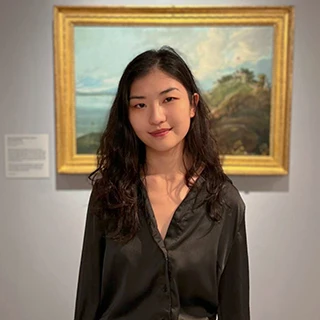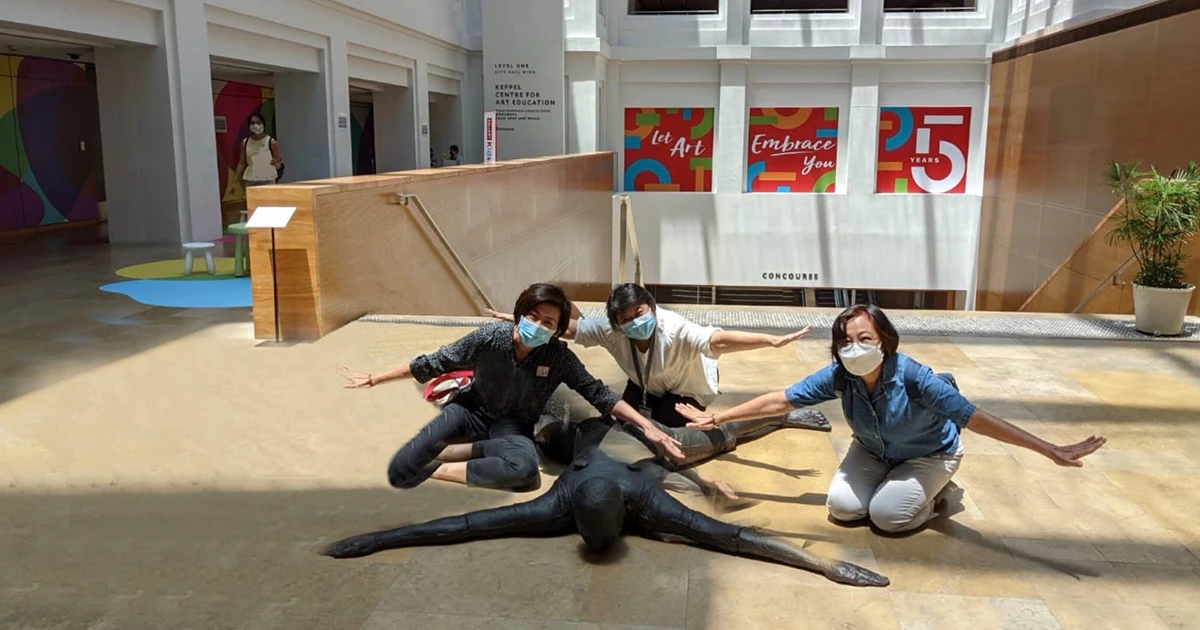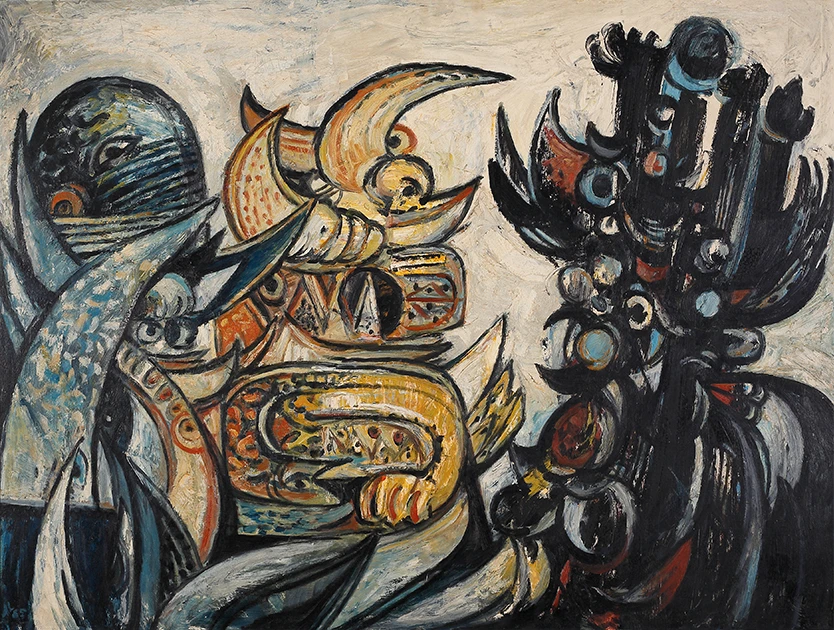Volunteer Voices: Co-Creating Wu Guanzhong: Travelling with the Master
For our 2022 special exhibition "Wu Guanzhong: Travelling with the Master, the Gallery invited four of our docents to co-create the show. In this article, Sim Mei-Ann speaks to the docents Tina Nixon, Gertrude Tan, Queenie Chow and Stella Rong to find out more about their experience of developing an exhibition—from choosing the artworks, uncovering a documentary about Wu's 1990 trip to Singapore, and finally leading tours for the show that they put together!
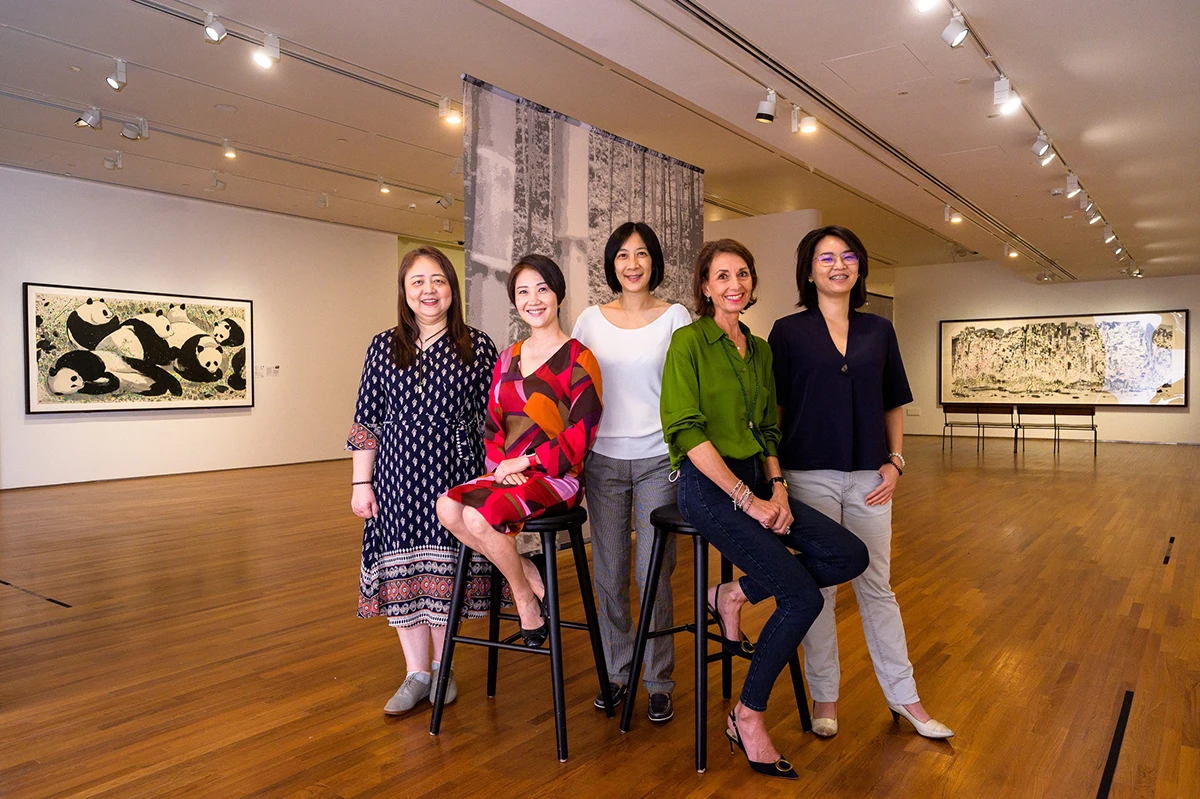
Wu Guanzhong: Travelling with the Master (9 July–30 October 2022) was an exhibition that adopted new approach to developing exhibitions—it was the first time National Gallery Singapore invited docents to co-create one. The Best Friends of the Gallery (BFG) team invited the four docents who worked on the project—Tina Nixon, Gertrude Tan, Queenie Chow and Stella Rong—to share their experiences.
1. Can you introduce yourself, and what you do as docents?
Hello. My name is Tina Nixon and I have been a docent here since the Gallery opened in 2015. I am also a docent for Friends of the Museums at Singapore Art Museum, and have worked as a docent for many museums worldwide.
My name is Queenie Chow Wai Lee and I moved to Singapore in 1993 to pursue a career in the aviation supplies industry. I am now a freelance trainer that gives Business Mandarin courses to local institutes and teaches Mandarin to non-native speakers. I have been actively volunteering as a docent in our local museums and galleries since 2011 and joined the Gallery as a docent in 2015.
My name is Stella Rong Yiyi, and I’m the third member of the team. I moved to Singapore with my family in 2005. I work in the finance sector and deal with numbers daily. It was through a serendipitous encounter that I started volunteering as a museum docent in Singapore, before becoming a Mandarin docent at the Gallery in 2015.
And finally, my name is Gertrude Tan Yam Hua, the fourth member of our team. I am a full-time lecturer at a tertiary institution, and have been an active docent for almost 20 years with several local art and cultural museums. Before the opening of the Gallery in 2015, I helped design its inaugural docent training programme, and I continue to train and mentor new docents keen to join our community.
As docents, our job is to guide people through the Gallery’s exhibitions. We explain its concept, artists, and provide the audience with general background information as well as share interesting stories and anecdotes that will make the exhibition more meaningful and memorable. Hopefully, they tell their friends and family about the great experience they’ve had, then tell everyone else to visit! The audiences range from school groups, corporate tours, community groups or the general public, so one must adjust the tour according to the demographic of the participants. As such, a docent’s skill lies in quickly gauging how knowledgeable the audience is, then adapting the narrative to suit their needs.
2. How did you come up with the concept and theme of Wu Guanzhong: Travelling with the Master?
In 2021, four of us were given an opportunity to co-create an exhibition of Wu Guanzhong featuring his works from the National Collection. In fact, this opportunity went beyond curating the artworks, and we were also involved in other aspects of the project, which included programming, marketing and design. So, what does a curator actually do? We were about to find out by jumping in the deep-end headfirst!
One of the first tasks was to put together a proposal and an outline of a theme or narrative of the exhibition. What story did we want the visitors to take away from viewing the works of this great master? With that in mind, we began to select a number of artworks we would like to see on display. Initially, we chose our favourites as a starting point, but realised we couldn't just have a show based on our top ten choices, as much as that would have made each of us happy.
Fortunately, the four of us had guided Wu Guanzhong’s previous exhibitions at the Gallery and were familiar with his work. It would have been difficult without that knowledge as we weren’t able to see the works in person until they were installed for the exhibition. We therefore looked at images of his work online, and reviewed A4 prints. As docents, we know that this is a very different experience from seeing the work in person, which allows the viewer the details and observe the brushstrokes up close. It is actually one of the reasons it is so vital for docents to have a curator walk-through before each exhibition opens, as we get to see and compare the artworks in person.
After much deliberation, we hit on the travel theme and titled the exhibition: Wu Guanzhong: Travelling with the Master. There were several reasons why we came to this narrative. First, we had many landscape paintings in our collection. Second, we had personal photos that resonated with Wu’s works, and third, we had all been restricted from travelling due to the pandemic. We wanted to take you on a journey with us in exploring his mind, his homeland, the wider world as well as discovering the various techniques and media he used to create works of such different styles. There were so many different aspects to this theme that seemed to suit the present time and mood.
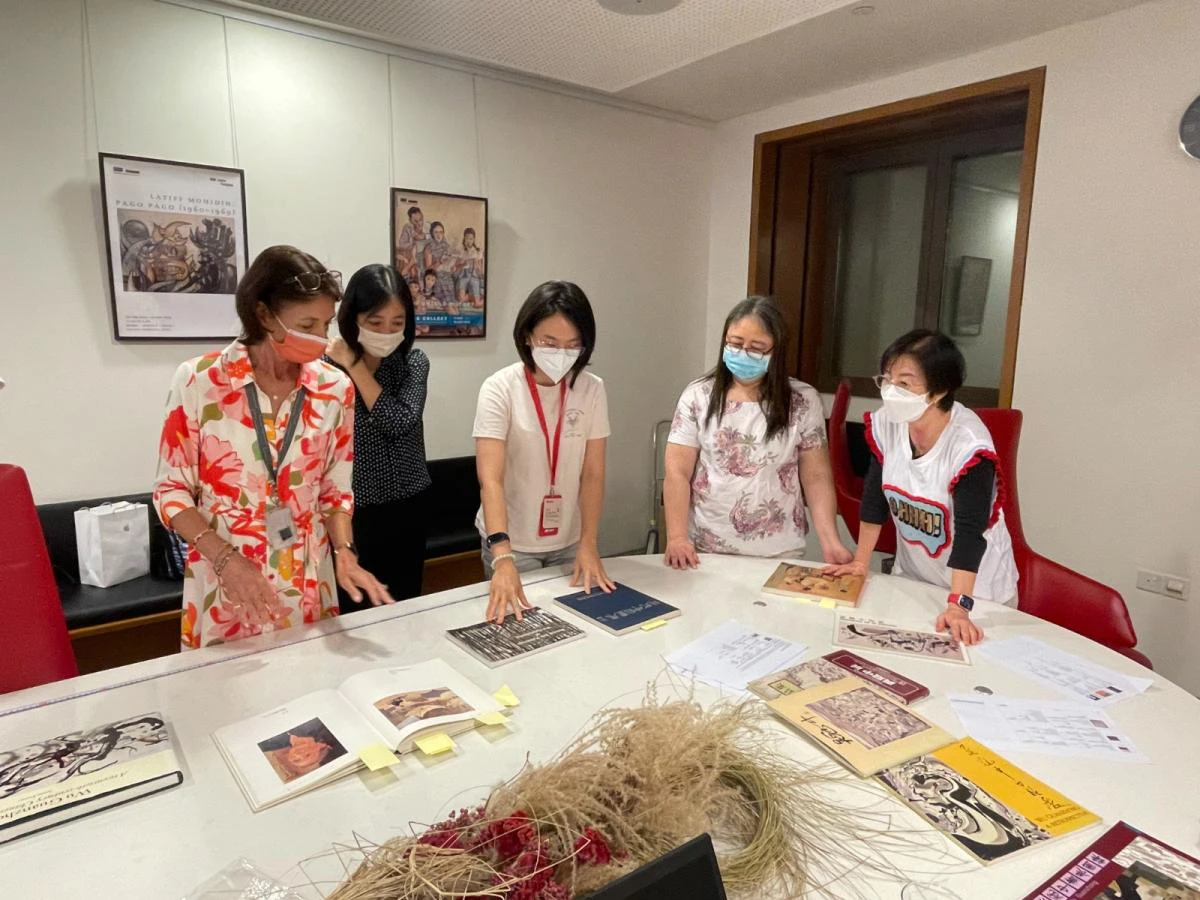
3. What did curating and organising Wu Guanzhong: Travelling with the Master entail?
One interesting aspect was that despite not knowing each other prior to this project, we all worked extremely well together, and if one person had a bright idea, we all agreed to put it forward. Each person played to their strengths, whether that was on the technical front, the knowledge base, creative ideas, language skills or time-keeping. We were aware that we did not have a lot of time to finalise the details of the project, and therefore became very focused and efficient in our decisions. A good idea was a good idea – “let’s put it in,” we would say. There was no room for dilly-dallying!
Since the travel theme appealed to all of us, we explored it in more detail and thought it would be rather fun to incorporate our own experiences of travelling into the exhibition. That meant trawling through thousands of personal photos that Queenie, Stella and Gertrude had, many of which related to trips to China to some of the same locations that Wu had travelled to. In Stella’s case, her grandparents came from the same hometown as Wu did and she was able to show photos from this area. In Tina’s case, seeing Wu’s artworks brought back memories of a backpacking trip she had undertaken in her youth, when she spent four months travelling round China with no money and no Mandarin skills. She had boxes of slide film from her travels all those years ago. We decided it would connect well with the audiences if we could share our collective photos and experiences of our travels, so we built on the idea of postcards, which we later turned into our extended labels.
By then we had a theme, a narrative and 47 chosen artworks. Next came the most challenging aspect of the project. Writing the text for the wall panels, extended labels, and the accompanying booklet… in two languages… against a tight deadline! One of the criteria for this exhibition was that it had to be bilingual, so luckily our team was fluent in Mandarin and English. We had to be careful in our editing, as this would impact the translators and the deadlines, giving us another reason to be very focused and succinct!
We also worked to locate and purchase some catalogues from previous exhibitions that featured Wu’s art, especially earlier ones and the seminal exhibitions abroad such as in Japan, USA, Hong Kong and at The British Museum in 1992. These would help us to illustrate how widely-travelled he was, how widely his works travelled, and how well-regarded his art was internationally from the late 1970s onwards. Since these publications are now in the collection of the Gallery’s Library and Archive, it also meant that those catalogues will be accessible to future projects and researchers.
With the hard graft of writing polished off, next came the fun part of choosing ten artworks from our collection to put in our marketing materials, as well as putting together an interesting programme for public talks and events to accompany the exhibition.
One of the highlights was uncovering and tracking down a thirty-minute documentary that had been made when Wu visited Singapore in 1990. It was called The Tuesday Report and followed him as he went to several locations across Singapore in search of artistic inspiration. He was seen in the documentary in the Jurong Bird park, at the Changi Sailing Club and along South Beach Road where he was filmed sketching An Indian Temple in Singapore, a work that is featured in the exhibition. We also managed to get in touch with Madam Ong Lay Hong, who was the producer and director of the documentary, and had personally spent time interviewing the artist. She attended the screening of the film and was there to give the audience her first-hand impressions of meeting him. You can watch the recording of this programme through the Gallery’s YouTube page.
We also met the Gallery’s exhibition design team who steered us through their thoughts and ideas of how to present this exhibition to the public. We looked at a myriad of colour charts, and considered a variety of screens that could create intimate areas and sub-divisions within the gallery space. Here, we were fortunate enough to have access to some fantastic archival photographs of Wu from the Gallery’s Library & Archive collection. By using some of these images of the artist, photographed at different locations, we were able to bring Wu into the Gallery with us, and have him present throughout the exhibition. Many of visitors commented on how much they liked the screens and how well they worked in the space.
4. What was it like to witness the fruits of your labour, and to subsequently guide tours for Wu Guanzhong: Travelling with the Master?
One of the most exciting parts of working on this project must be when the first day to install the artworks dawned upon us. So many artworks had arrived overnight—all wrapped up in their protective covers—and we finally got to see the paintings in all their glory as they lined up on the floor, waiting patiently to be given their allocated spots. At a certain point during the first day, Tina just couldn’t resist a sneak peak of the massive four metre-long painting of Zhangjiajie as it sat on the floor, still covered with cardboard!
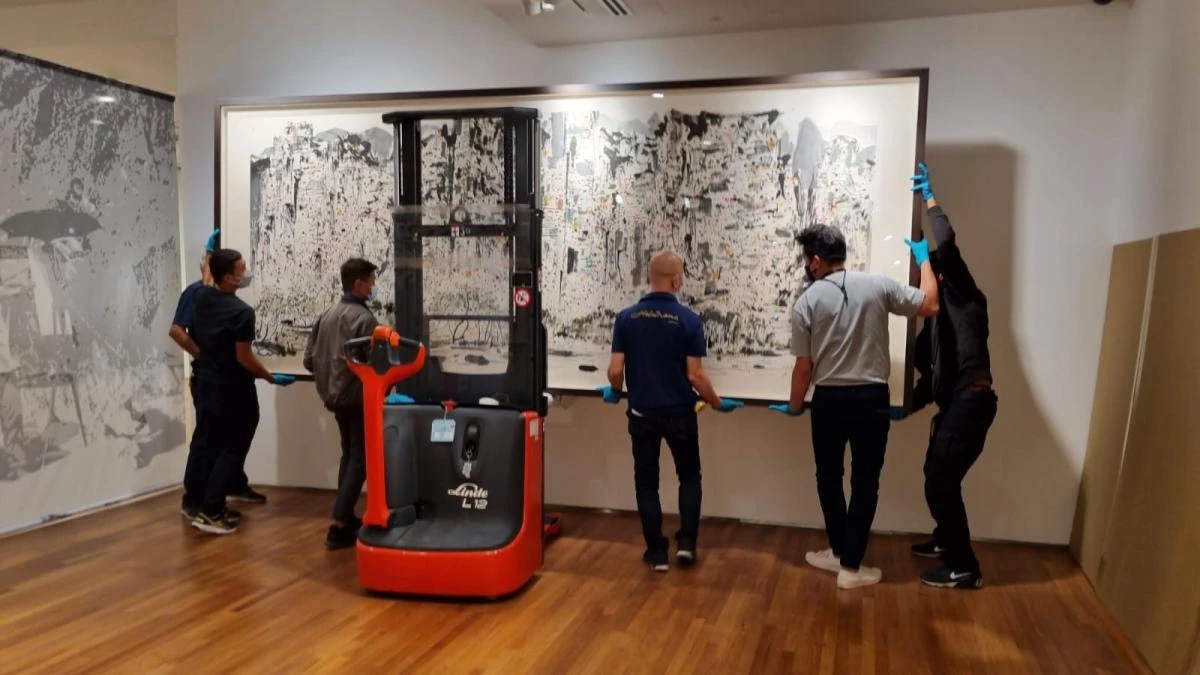
Of course, in terms of excitement and satisfaction, nothing beats the moment when the exhibition is finally open to the public and you get to witness people interacting with the works. Some have never heard of the artist, others are experts; there are those who have heard of “Wu Guanzhong” before, and others who have made a journey to the Gallery just to see his art. At the Visitor Services desk, someone overheard that a couple had come to the Gallery specially to see the exhibition, but were a week too early! It is a joy and pleasure to share Wu’s work with the wider world and to ensure more people become his fans. And with the show open, it was back to our usual job as docents!
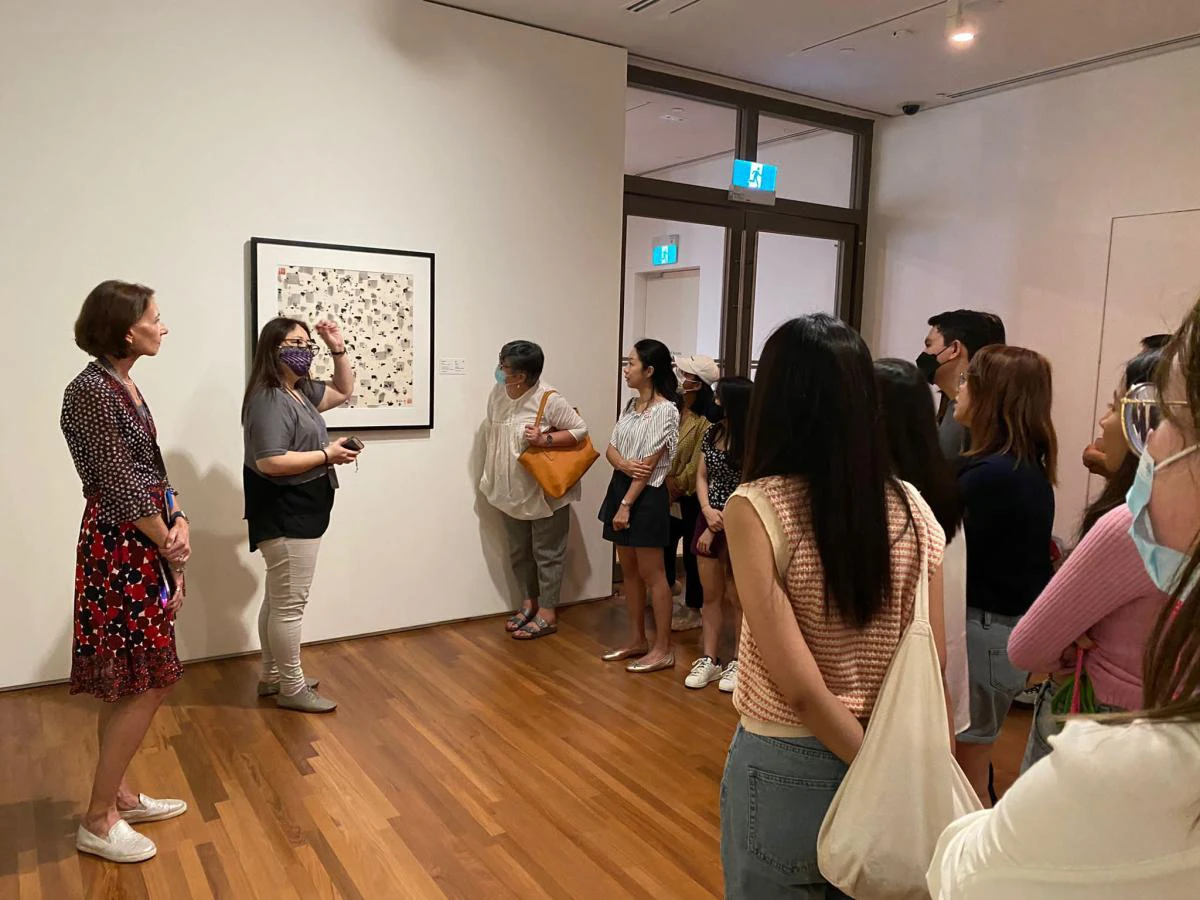
Editor's note: The exhibition booklet for Wu Guanzhong: Travelling with the Master is available for purchase at The Gallery Store by ABRY. The Gallery Store also stocks other publications showcasing Wu’s artworks and practice, including Wu Guanzhong: Beauty Beyond Form and Seeing the Kites Again: The Wu Guanzhong Donation Collection.










